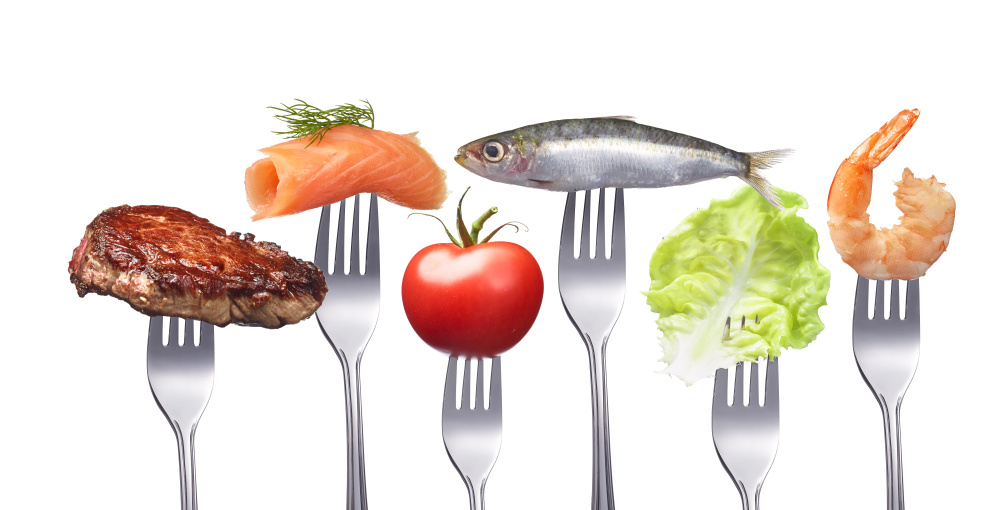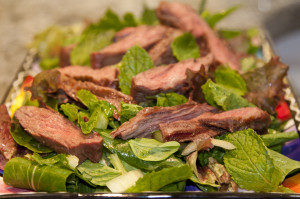You asked for it. I just hope you really want to know: How we eat may be just as important as what we eat—depending on your health and health goals.
 Food is your #1 ally. While certain supplements can help certain situations, supplements cannot make up for poor diet.
Food is your #1 ally. While certain supplements can help certain situations, supplements cannot make up for poor diet.
Most Americans believe that any number of different foods can be digested at the same time. Well, this isn’t what’s meant by food combining and may be why more than half of us suffer from some sort of digestive distress that no manner of elimination or medication can seem to fix. As sales of antacids soar off the charts, maybe it’s time to rediscover the art of food combining.
But before we dive into this topic, just know that I haven’t posted anything about food combining before for a couple reasons, the first and most glaring excuse is that I don’t strictly follow these rules myself. In fact, it wasn’t until a client asked me about this almost two years ago that I even bothered to find out whether there is any rationale or legitimacy to this practice.
The second reason is that, for most people, food combining is not the first place to start. A SAD person (Standard American Diet) needs more basic switches—usually reducing sugar and carbs, drinking a lot more clean water, eating many more veggies, and also usually decreasing seed oils while increasing healthy fats. Following strict food combining rules as a first step makes no more sense than suddenly running 10 miles a day. The one single scientific, peer-reviewed study that evaluated food combining compared it with a strategy that just reduced carbohydrates while increasing fats and proteins—but didn’t worry about combinations. The envelope please… both diets produced equal weight loss, equal preservation of lean body mass, correction of inflammatory indicators, and better cholesterol profiles.
End of disclaimers… because… because I do get a lot of emails, and it has now become my professional observation that for many, the basic anti-inflammatory steps don’t go far enough to calm digestive chaos, here are the key food combining principles. It does seem to help heal stubborn digestive issues.
Food combining reflects the principles governing digestion
Nutrition is a series of four processes that make genuine building blocks for your body to use:
- Digestion
- Absorption
- Assimilation
- Elimination
Your body does this using two basic approaches:
- Mechanical (chewing, churning, and peristalsis to move food along the digestive tract)
- Chemical digestion (enzymes, acids, probiotics…)
Indigestion and irritable bowel syndrome are modern phenomena
The brain child of Dr. William Hay who, after years of medical practice found his own health in shambles with high blood pressure, heart disease and massive weight gain, completely handled all his symptoms and lost 50 pounds in just a few months using nutrition alone. Today, the scientific community is showing the strong connection between carbohydrates and allergies, diabetes, skin problems, migraines, depression, chronic fatigue, and psychiatric disorders—however, Dr. Hay took the problem of eating the wrong foods a step farther.
Enzymes and acids are carefully secreted into your stomach and small intestine in response to signals from your mouth to inform those organs what you are eating. Each different food requires unique digestive enzymes (even foods in the same basic category, like wheat and barley—or sometimes different proteins) and those enzymes are affected by different levels of acidity. High acid levels in the stomach will activate certain protein-digesting enzymes. But acid isn’t needed or even made at as high a level for digesting starchy foods—enzymes that digest starchy foods need alkaline.
Dr. Hay reasoned that if specific enzymes are used to digest certain food, and in some cases also compete with each other, then competing foods should not be eaten together. And also, foods will be more properly digested to the extent that all foods eaten at the same time are processed by the same (or possibly compatible) enzymes.
Too many different foods combined in one meal confuse the body—not all enzymes are made or available at once
That meat and cheese sandwich on bread slathered with mayonnaise and eaten with a side of fries (even all organic, grass-fed, raw, and sprouted sweetened with raisins) is a lot of different foods.
If your chewing senses carbohydrates it sets the body up to digest carbohydrates. But that means the enzymes available to digest proteins and fats are probably not also ready and waiting when the food arrives. The bread digests, the meat, cheese, and mayo… they rot, putrefy, and cause belching, heartburn, GERD… and if improperly digested food particles make it to the large intestine, a few hours later you’ll feel intestinal gas, bloating and perhaps abdominal pain.
Usually we start handling upset digestive symptoms by looking for one culprit food. We use food journals to figure out what that one or maybe several food might be and take steps to address that. But when the going gets complicated, use your food journal to see if violating any of the principles of food combining can help correct your digestion until your body heals a bit more. Simplicity is always better for healing.
Good digestive outcome requires meals comprised of similar food types
When foods are improperly combined, fermentation and digestive distress is the likely outcome. When foods eaten at a meal are of the same type, proper digestion takes place. Most foods contain a little of everything. The rules for combining foods refer to what a food is most concentrated in: starches, sugars, fats, proteins or the special group: protein-fats.
The basic rules of food combining:
1: Never eat high-protein with starchy high-carbohydrate foods
Each macronutrient group (carbohydrates, protein, fats) is best kept separate and should not be combined at all. Pizza? No. Steak and Potatoes? Sorry. Not even rice and beans. But any and all of these different foods combine well with green and/or non-starchy vegetables. Green veggies actually aid the digestion of starches, proteins and fats. Egg and spinach omelet? Hold the hash browns. Steak and salad? Yummy.
Why: Protein digestion uses an enzyme named pepsin that requires an acid medium. pepsin is activated by high levels of hydrochloric acid in the stomach. Digestion of carbohydrate dense foods requires an alkaline environment. Mixing high carbohydrate foods with high protein foods will inhibit each other’s digestion. The foods will ferment producing indigestion, bloating and gas. It can be individual, but inhibited protein is usually felt as stomach upset (acid indigestion) and inhibited carbohydrate digestion isn’t handled until the large intestine becomes gassy and bloated.
 1A: Animal protein foods are best digested when accompanied by a fresh greens.
1A: Animal protein foods are best digested when accompanied by a fresh greens.
1B: Plant-based protein foods (nuts and seeds) combine well with acid fruits such blackberries, or strawberries. They also work fairly well with sub-acid fruits like apples, cherries, mangos, or peaches. The vitamin C in these fruits aids digestion of the mixture.
2: Never combine high-protein and high-fats (note: this does not apply to the fat that is already part of a protein food)
Fats are not changed much in the stomach but they slow digestion of everything else. Fats inhibit the secretion of the gastric juices needed to digest muscle meat, fish, dairy products, nuts, and eggs by as much as fifty percent. When fat concentrated foods are eaten with protein concentrated foods, the digestive breakdown of both take longer. Because the fats remain undigested in the stomach for a long period of time, they can putrify and become rancid. This is why fried chicken can be so hard to digest. An important detail: although some high protein foods also contain high amounts of fat, these fats will be held in suspension awaiting breakdown without slowing gastric action. Added fats like large amounts of oil, butter and milk fat will coat the gastric mucosa, inhibiting gastric juice. The key point is also quantity, a dab of cooking oil is far healthier and digestible than a non-stick pan.
3: Don’t consume two concentrated proteins at the same meal
The kosher law of separating meat and dairy at meals, and waiting a certain amount of time after eating one before eating the other honors the way the body handles different proteins. Each type of protein requires a specific character, strength and timing of digestive juice secretions. Two proteins with different characters and compositions usually call for different types and strengths of digestive juices. One protein at a meal should be the rule. Don’t mix different types of animal protein, sorry surf and turf crowd; skip the steak and eggs.
3A: Drink dairy milk alone.
When milk from animals is consumed with other foods it tends to curdle, insulating itself from digestive enzymes. Milk products that are bacterial or lacto-fermented such as kefir, cheese, yogurt, and buttermilk do not cause this problem. But only combine them with green vegetables or berries.
4: Eat fruit and sweet foods alone.
This one’s for the “eat dessert first” crowd. Although we traditionally end a meal with dessert, because fruit and sweet foods have relatively simple carbohydrate structures they digest very quickly. If you eat that (nut-flour, maple syrup) cookie after dinner, within 15 minutes when its sugars/starches have now broken down and these become beautiful deserts for some unwanted guests that might be living in your digestive tract and can ferment this into alcohol. Crazy as it sounds, some people actually feel a bit drunk (brain fog). Eat fruit at least 30 minutes before a meal or wait 4 hours after. A piece of fruit first thing in the morning is terrific; just wait half an hour before eating a full breakfast.
4A: Don’t combine acid fruits (or other acid foods) with carbohydrates
An enzyme in mouth saliva called amylase begins the breakdown of starch concentrated foods converting them into more simple sugars. This enzyme requires a neutral or slightly alkaline environment, the healthy condition of the mouth. When we eat acid foods at the same time, this does drop the mouth pH, the amylase enzyme works less efficiently, other areas of the body have to now digest the carbohydrates—which can overwork other organs while not being very efficient. Poorly digested starch and sugars making it all the way into the large intestine are broken down there by good bacteria—except this is the wrong location for breaking down sugars and starches and becomes gas, bloating, even diarrhea. Spaghetti and tomato sauce is very bloating for a lot of people. So is jam on toast.
4B: Don’t combine acid fruits (or other acid foods) with proteins
Acid fruits slow protein digestion. The typical American orange juice, bacon, eggs and toast breakfast is such a digestive nightmare. Dr. Pavlov actually showed that by inhibiting the flow of gastric juice—protein foods demand an unhampered flow—instead of digestion the result is putrefaction. Nuts and fresh cheese are about the only protein foods that may be combinable. Nuts are actually not that high in protein while higher in fat, making them a “protein fat. I believe that in some quarters health professionals are taught (and therefore tell clients) that acid fruits like grapefruit, lemon, pineapple, etc can help digest proteins. The acid actually retards protein digestion despite the presence of some fruit enzymes.
4C: Melons: eat them alone or leave them alone
Watermelon, cantaloupe, honeydew, and the more exotic melons should always be eaten away from mealtime and alone. Melons digest quickly, very quickly, see. Eat them first.
5: Starch and sugar
Starches disguised as sweets are enzyme unfriendly (among other digestion and broader health problems). Although the “treat” produces an abundance of saliva, the enzyme needed to digest the starch (called ptyalin) is never released because the sugar has turned the environment acidic. Layer on the jam, syrup, or sugar coating and the accompanying starches now ferment in the stomach while awaiting the completion of starch digestion.
Fermentation means sour stomach, discomfort. This applies to natural sweets too. That pancake breakfast with pure, enzyme and mineral-rich maple syrup is truly for the healthy and on an occasional basis only.
That jelly donut or “heart healthy” honey granola are both going to settle on your digestive tract like a sack of bricks. The carbohydrates are fermenting in the body, producing noxious gases, alcohol, brain fog and inflammation. When undigested short carbohydrates and sugars reach your large intestine (after wrecking havoc on the microbiome of your small intestine) they ferment (gas and pain) and these undigested sugars also draw water into the intestine (diarrhea).
6: Eat just one concentrated starch food at a meal
This is my invented rule to address our great nation’s over-consumption of starches. Too many starchy foods can definitely overwhelm all the factors leading to their proper digestion and lead to fermentation. They can, and over a fairly short time, change the bacteria living in the gut to unfriendly and non-helpful pathogens. I’ve no certainty that it takes a combination of two starches to do this, could be many large plates of pasta night after night as well.
AND – the bonus rule: Never drink a lot of water with meals
Water dilutes the salivary enzymes, stomach fluids, and intestinal enzymes making everything work less well.
 And, and… The Exceptions:
And, and… The Exceptions:
Just to confuse inform you further…
- Foods that are high in fat and protein (cheese, yogurt, kefir, nuts, and oil-bearing seeds) are okay to combine with acidic (sour) fruit. Examples: tahini and lemon dressing, almonds and sour apples, yogurt and strawberries.
- Celery and lettuce can be eaten with fruits.
- Lemon, lime, and tomato can be eaten with green vegetables.
Remember, the goal of food combining is digestive bliss.
But don’t create confusional stress and overwhelm in the process. Just eat simply. Meals that contain the smallest number of courses will produce better digestive results. A one course meal of uncomplicated ingredients is ideal.
And green is my favorite color
[contact-form-7 id=”1851″ title=”Question form blog page”]
References:
Grant, Doris & Joice, Jean, Food Combining for Health: Get Fit with Foods that Don’t Fight. Healing Arts Press, 1985
Pitchford, Paul. Healing with Whole Foods. Berkeley, California: North Atlantic Books, 2003.
Haas, Elson M. Staying Healthy with Nutrition: The complete guide to diet and nutritional medicine. Berkley, CA: Wiley, 2006.
Golay A, Allaz AF, Ybarra J et al. Similar weight loss with low-energy food combining or balanced diets. Int J Obes Relat Metab Disord. 2000 Apr;24(4):492-6.







